Global Business Management: Woolworths Retail Industry Case Study
VerifiedAdded on 2022/10/11
|6
|1525
|23
Case Study
AI Summary
This assignment analyzes the Woolworths retail industry in Australia, focusing on its market position and strategic decisions within the global context. The case study begins with an overview of the retail sector, highlighting Woolworths' operations, product offerings, and market share. It then delves into the application of Porter's Five Forces framework to assess the competitive dynamics, including the threat of new entrants, bargaining power of suppliers and buyers, the threat of substitutes, and rivalry among existing competitors. The analysis also considers the company's global strategy, including the adoption of different international strategies. The document provides recommendations, including analyzing the international market, conducting a value chain analysis, improving supply chain efficiency, and adopting a people-focused development strategy. The analysis emphasizes the importance of adapting to local needs and leveraging opportunities for new markets. The study also emphasizes the importance of adapting to local needs and leveraging opportunities for new markets. The study also provides insights into the importance of strategic management and the factors that influence business development in the retail sector.
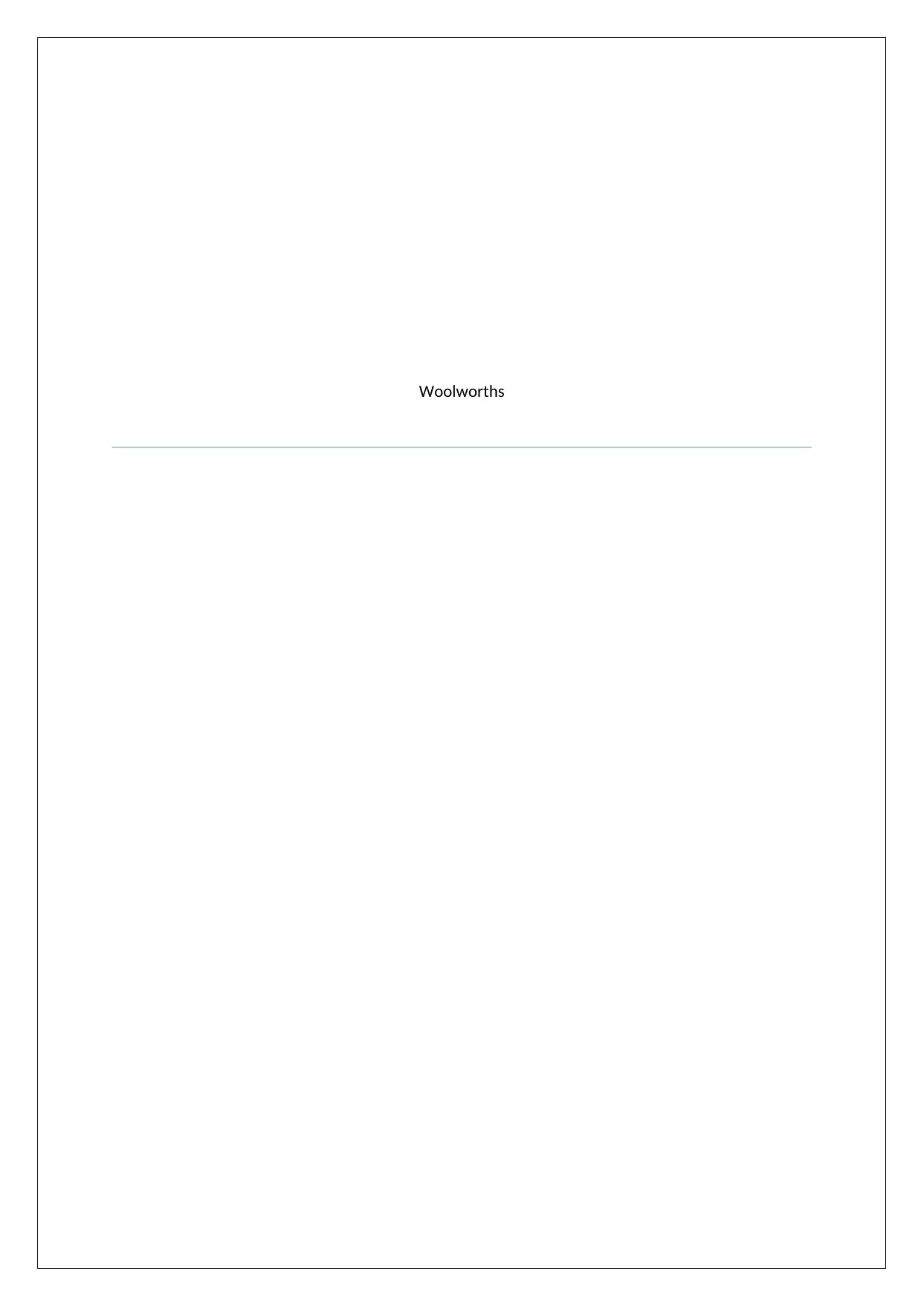
Woolworths
Paraphrase This Document
Need a fresh take? Get an instant paraphrase of this document with our AI Paraphraser
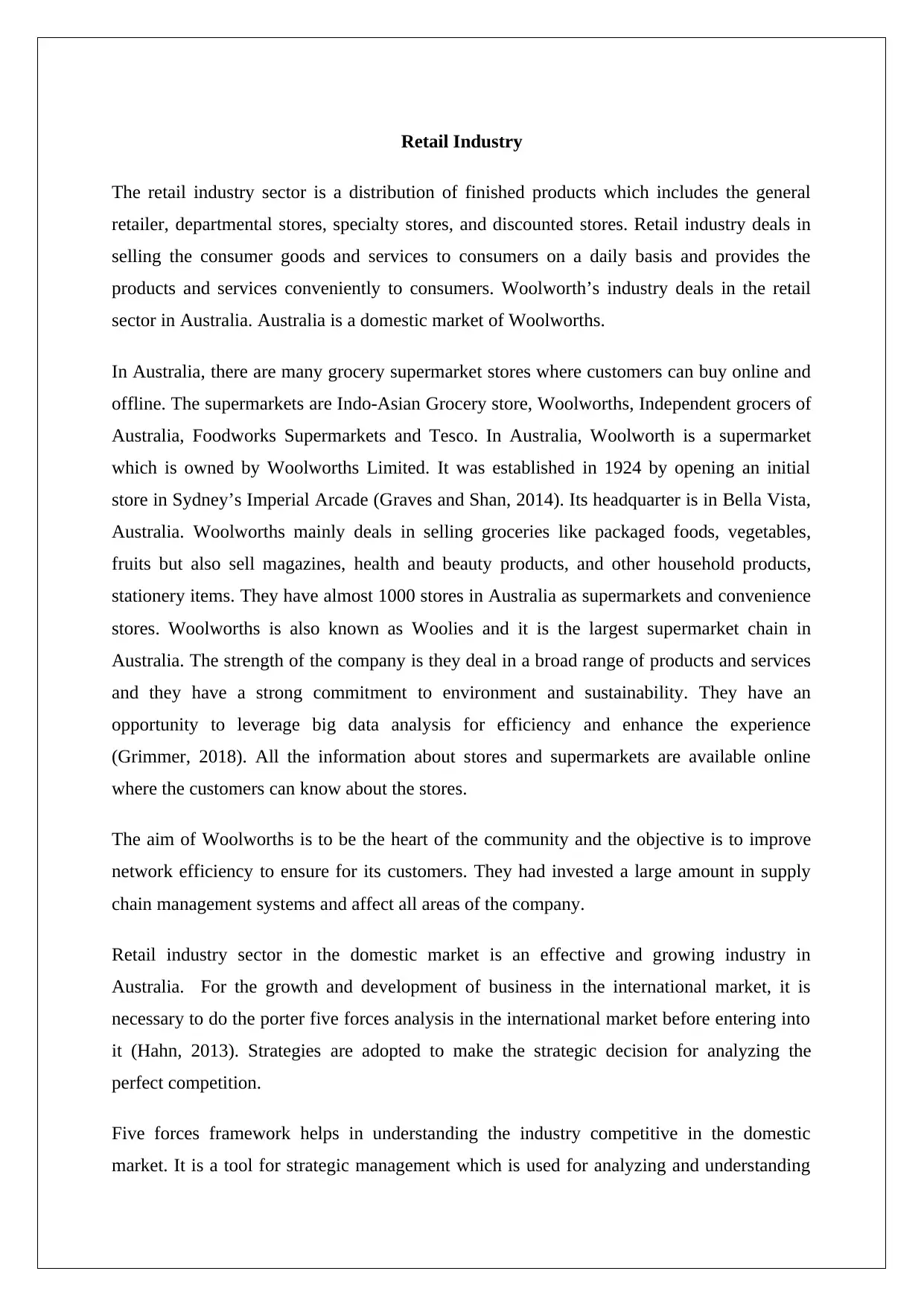
Retail Industry
The retail industry sector is a distribution of finished products which includes the general
retailer, departmental stores, specialty stores, and discounted stores. Retail industry deals in
selling the consumer goods and services to consumers on a daily basis and provides the
products and services conveniently to consumers. Woolworth’s industry deals in the retail
sector in Australia. Australia is a domestic market of Woolworths.
In Australia, there are many grocery supermarket stores where customers can buy online and
offline. The supermarkets are Indo-Asian Grocery store, Woolworths, Independent grocers of
Australia, Foodworks Supermarkets and Tesco. In Australia, Woolworth is a supermarket
which is owned by Woolworths Limited. It was established in 1924 by opening an initial
store in Sydney’s Imperial Arcade (Graves and Shan, 2014). Its headquarter is in Bella Vista,
Australia. Woolworths mainly deals in selling groceries like packaged foods, vegetables,
fruits but also sell magazines, health and beauty products, and other household products,
stationery items. They have almost 1000 stores in Australia as supermarkets and convenience
stores. Woolworths is also known as Woolies and it is the largest supermarket chain in
Australia. The strength of the company is they deal in a broad range of products and services
and they have a strong commitment to environment and sustainability. They have an
opportunity to leverage big data analysis for efficiency and enhance the experience
(Grimmer, 2018). All the information about stores and supermarkets are available online
where the customers can know about the stores.
The aim of Woolworths is to be the heart of the community and the objective is to improve
network efficiency to ensure for its customers. They had invested a large amount in supply
chain management systems and affect all areas of the company.
Retail industry sector in the domestic market is an effective and growing industry in
Australia. For the growth and development of business in the international market, it is
necessary to do the porter five forces analysis in the international market before entering into
it (Hahn, 2013). Strategies are adopted to make the strategic decision for analyzing the
perfect competition.
Five forces framework helps in understanding the industry competitive in the domestic
market. It is a tool for strategic management which is used for analyzing and understanding
The retail industry sector is a distribution of finished products which includes the general
retailer, departmental stores, specialty stores, and discounted stores. Retail industry deals in
selling the consumer goods and services to consumers on a daily basis and provides the
products and services conveniently to consumers. Woolworth’s industry deals in the retail
sector in Australia. Australia is a domestic market of Woolworths.
In Australia, there are many grocery supermarket stores where customers can buy online and
offline. The supermarkets are Indo-Asian Grocery store, Woolworths, Independent grocers of
Australia, Foodworks Supermarkets and Tesco. In Australia, Woolworth is a supermarket
which is owned by Woolworths Limited. It was established in 1924 by opening an initial
store in Sydney’s Imperial Arcade (Graves and Shan, 2014). Its headquarter is in Bella Vista,
Australia. Woolworths mainly deals in selling groceries like packaged foods, vegetables,
fruits but also sell magazines, health and beauty products, and other household products,
stationery items. They have almost 1000 stores in Australia as supermarkets and convenience
stores. Woolworths is also known as Woolies and it is the largest supermarket chain in
Australia. The strength of the company is they deal in a broad range of products and services
and they have a strong commitment to environment and sustainability. They have an
opportunity to leverage big data analysis for efficiency and enhance the experience
(Grimmer, 2018). All the information about stores and supermarkets are available online
where the customers can know about the stores.
The aim of Woolworths is to be the heart of the community and the objective is to improve
network efficiency to ensure for its customers. They had invested a large amount in supply
chain management systems and affect all areas of the company.
Retail industry sector in the domestic market is an effective and growing industry in
Australia. For the growth and development of business in the international market, it is
necessary to do the porter five forces analysis in the international market before entering into
it (Hahn, 2013). Strategies are adopted to make the strategic decision for analyzing the
perfect competition.
Five forces framework helps in understanding the industry competitive in the domestic
market. It is a tool for strategic management which is used for analyzing and understanding
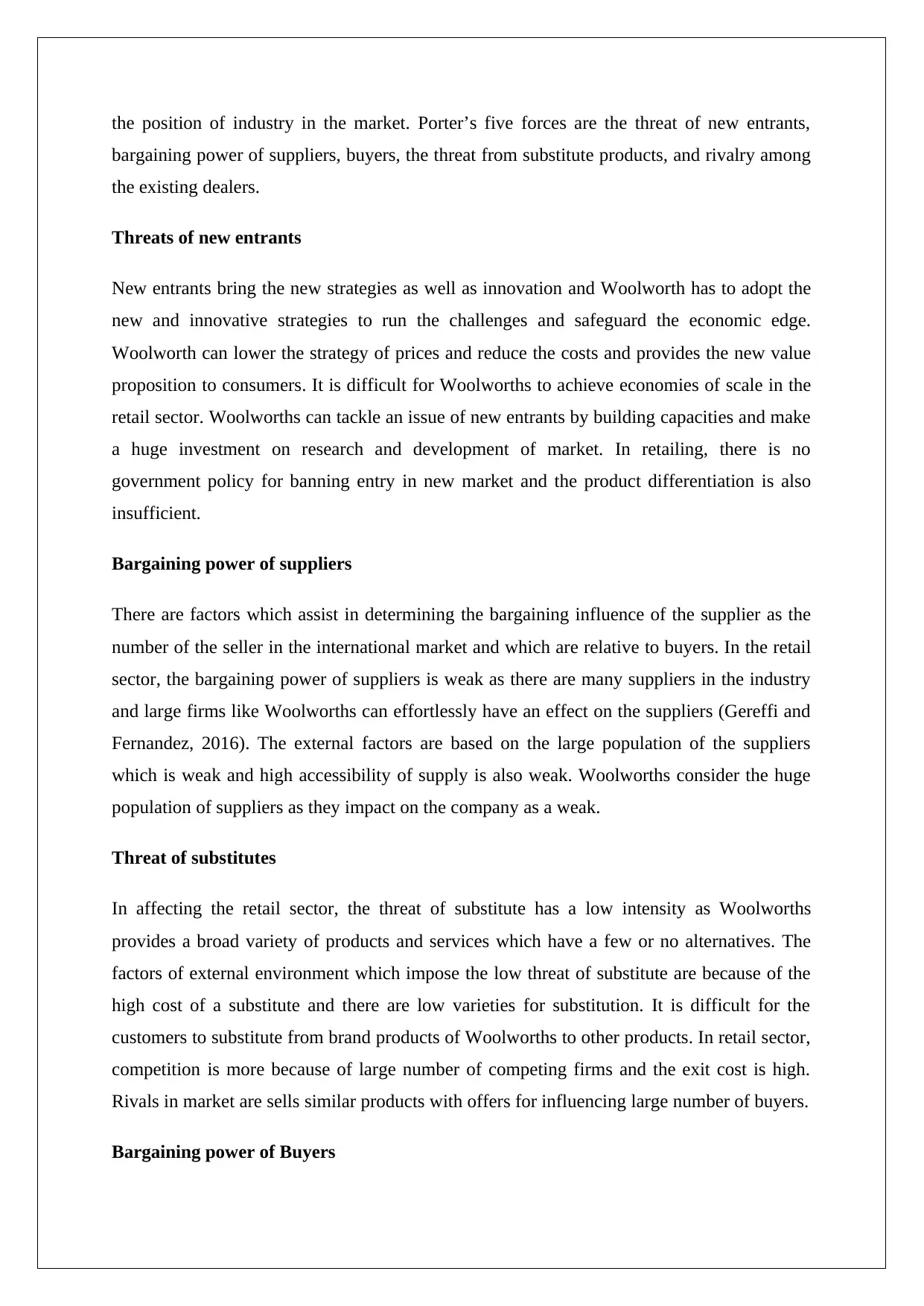
the position of industry in the market. Porter’s five forces are the threat of new entrants,
bargaining power of suppliers, buyers, the threat from substitute products, and rivalry among
the existing dealers.
Threats of new entrants
New entrants bring the new strategies as well as innovation and Woolworth has to adopt the
new and innovative strategies to run the challenges and safeguard the economic edge.
Woolworth can lower the strategy of prices and reduce the costs and provides the new value
proposition to consumers. It is difficult for Woolworths to achieve economies of scale in the
retail sector. Woolworths can tackle an issue of new entrants by building capacities and make
a huge investment on research and development of market. In retailing, there is no
government policy for banning entry in new market and the product differentiation is also
insufficient.
Bargaining power of suppliers
There are factors which assist in determining the bargaining influence of the supplier as the
number of the seller in the international market and which are relative to buyers. In the retail
sector, the bargaining power of suppliers is weak as there are many suppliers in the industry
and large firms like Woolworths can effortlessly have an effect on the suppliers (Gereffi and
Fernandez, 2016). The external factors are based on the large population of the suppliers
which is weak and high accessibility of supply is also weak. Woolworths consider the huge
population of suppliers as they impact on the company as a weak.
Threat of substitutes
In affecting the retail sector, the threat of substitute has a low intensity as Woolworths
provides a broad variety of products and services which have a few or no alternatives. The
factors of external environment which impose the low threat of substitute are because of the
high cost of a substitute and there are low varieties for substitution. It is difficult for the
customers to substitute from brand products of Woolworths to other products. In retail sector,
competition is more because of large number of competing firms and the exit cost is high.
Rivals in market are sells similar products with offers for influencing large number of buyers.
Bargaining power of Buyers
bargaining power of suppliers, buyers, the threat from substitute products, and rivalry among
the existing dealers.
Threats of new entrants
New entrants bring the new strategies as well as innovation and Woolworth has to adopt the
new and innovative strategies to run the challenges and safeguard the economic edge.
Woolworth can lower the strategy of prices and reduce the costs and provides the new value
proposition to consumers. It is difficult for Woolworths to achieve economies of scale in the
retail sector. Woolworths can tackle an issue of new entrants by building capacities and make
a huge investment on research and development of market. In retailing, there is no
government policy for banning entry in new market and the product differentiation is also
insufficient.
Bargaining power of suppliers
There are factors which assist in determining the bargaining influence of the supplier as the
number of the seller in the international market and which are relative to buyers. In the retail
sector, the bargaining power of suppliers is weak as there are many suppliers in the industry
and large firms like Woolworths can effortlessly have an effect on the suppliers (Gereffi and
Fernandez, 2016). The external factors are based on the large population of the suppliers
which is weak and high accessibility of supply is also weak. Woolworths consider the huge
population of suppliers as they impact on the company as a weak.
Threat of substitutes
In affecting the retail sector, the threat of substitute has a low intensity as Woolworths
provides a broad variety of products and services which have a few or no alternatives. The
factors of external environment which impose the low threat of substitute are because of the
high cost of a substitute and there are low varieties for substitution. It is difficult for the
customers to substitute from brand products of Woolworths to other products. In retail sector,
competition is more because of large number of competing firms and the exit cost is high.
Rivals in market are sells similar products with offers for influencing large number of buyers.
Bargaining power of Buyers
⊘ This is a preview!⊘
Do you want full access?
Subscribe today to unlock all pages.

Trusted by 1+ million students worldwide
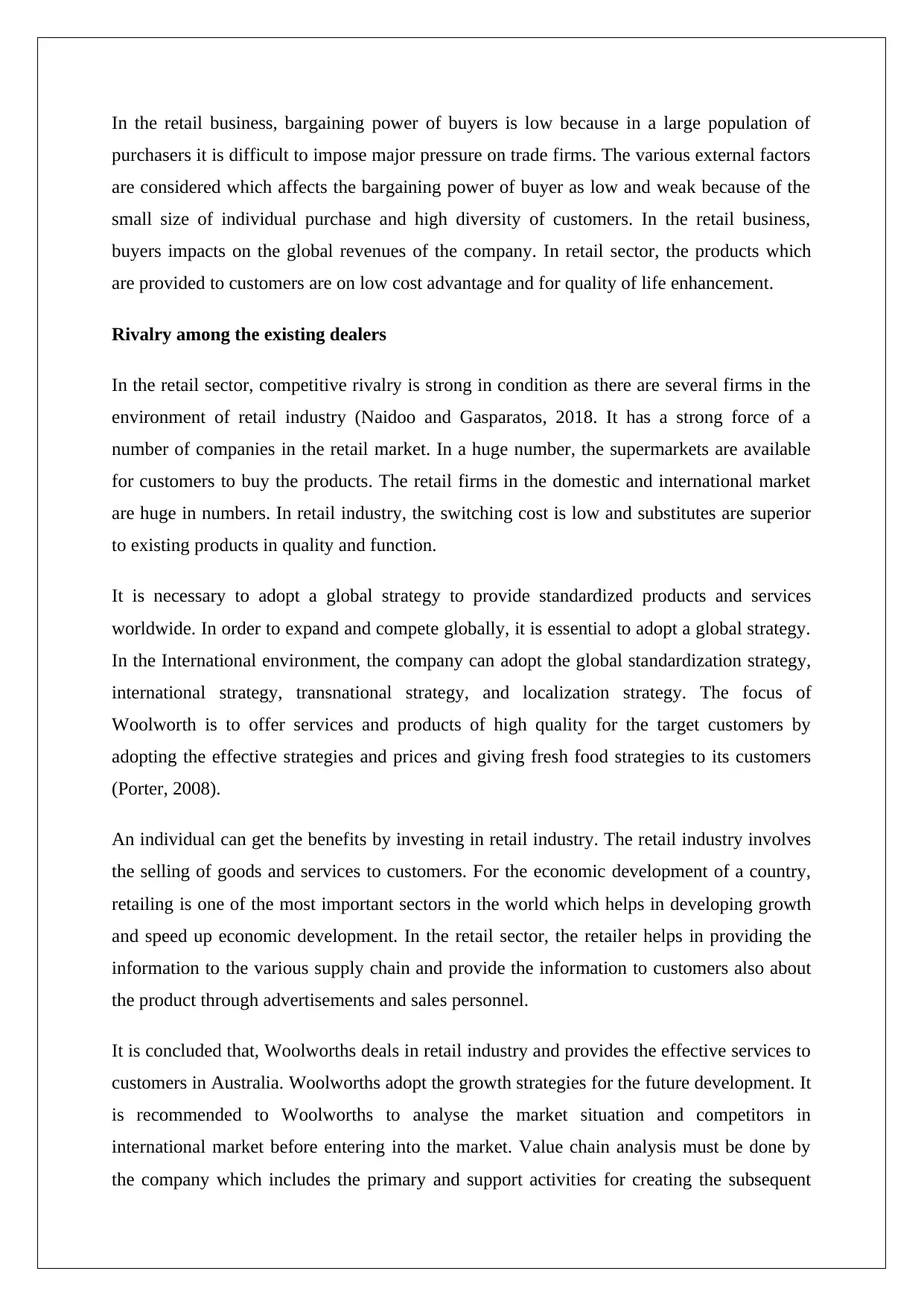
In the retail business, bargaining power of buyers is low because in a large population of
purchasers it is difficult to impose major pressure on trade firms. The various external factors
are considered which affects the bargaining power of buyer as low and weak because of the
small size of individual purchase and high diversity of customers. In the retail business,
buyers impacts on the global revenues of the company. In retail sector, the products which
are provided to customers are on low cost advantage and for quality of life enhancement.
Rivalry among the existing dealers
In the retail sector, competitive rivalry is strong in condition as there are several firms in the
environment of retail industry (Naidoo and Gasparatos, 2018. It has a strong force of a
number of companies in the retail market. In a huge number, the supermarkets are available
for customers to buy the products. The retail firms in the domestic and international market
are huge in numbers. In retail industry, the switching cost is low and substitutes are superior
to existing products in quality and function.
It is necessary to adopt a global strategy to provide standardized products and services
worldwide. In order to expand and compete globally, it is essential to adopt a global strategy.
In the International environment, the company can adopt the global standardization strategy,
international strategy, transnational strategy, and localization strategy. The focus of
Woolworth is to offer services and products of high quality for the target customers by
adopting the effective strategies and prices and giving fresh food strategies to its customers
(Porter, 2008).
An individual can get the benefits by investing in retail industry. The retail industry involves
the selling of goods and services to customers. For the economic development of a country,
retailing is one of the most important sectors in the world which helps in developing growth
and speed up economic development. In the retail sector, the retailer helps in providing the
information to the various supply chain and provide the information to customers also about
the product through advertisements and sales personnel.
It is concluded that, Woolworths deals in retail industry and provides the effective services to
customers in Australia. Woolworths adopt the growth strategies for the future development. It
is recommended to Woolworths to analyse the market situation and competitors in
international market before entering into the market. Value chain analysis must be done by
the company which includes the primary and support activities for creating the subsequent
purchasers it is difficult to impose major pressure on trade firms. The various external factors
are considered which affects the bargaining power of buyer as low and weak because of the
small size of individual purchase and high diversity of customers. In the retail business,
buyers impacts on the global revenues of the company. In retail sector, the products which
are provided to customers are on low cost advantage and for quality of life enhancement.
Rivalry among the existing dealers
In the retail sector, competitive rivalry is strong in condition as there are several firms in the
environment of retail industry (Naidoo and Gasparatos, 2018. It has a strong force of a
number of companies in the retail market. In a huge number, the supermarkets are available
for customers to buy the products. The retail firms in the domestic and international market
are huge in numbers. In retail industry, the switching cost is low and substitutes are superior
to existing products in quality and function.
It is necessary to adopt a global strategy to provide standardized products and services
worldwide. In order to expand and compete globally, it is essential to adopt a global strategy.
In the International environment, the company can adopt the global standardization strategy,
international strategy, transnational strategy, and localization strategy. The focus of
Woolworth is to offer services and products of high quality for the target customers by
adopting the effective strategies and prices and giving fresh food strategies to its customers
(Porter, 2008).
An individual can get the benefits by investing in retail industry. The retail industry involves
the selling of goods and services to customers. For the economic development of a country,
retailing is one of the most important sectors in the world which helps in developing growth
and speed up economic development. In the retail sector, the retailer helps in providing the
information to the various supply chain and provide the information to customers also about
the product through advertisements and sales personnel.
It is concluded that, Woolworths deals in retail industry and provides the effective services to
customers in Australia. Woolworths adopt the growth strategies for the future development. It
is recommended to Woolworths to analyse the market situation and competitors in
international market before entering into the market. Value chain analysis must be done by
the company which includes the primary and support activities for creating the subsequent
Paraphrase This Document
Need a fresh take? Get an instant paraphrase of this document with our AI Paraphraser
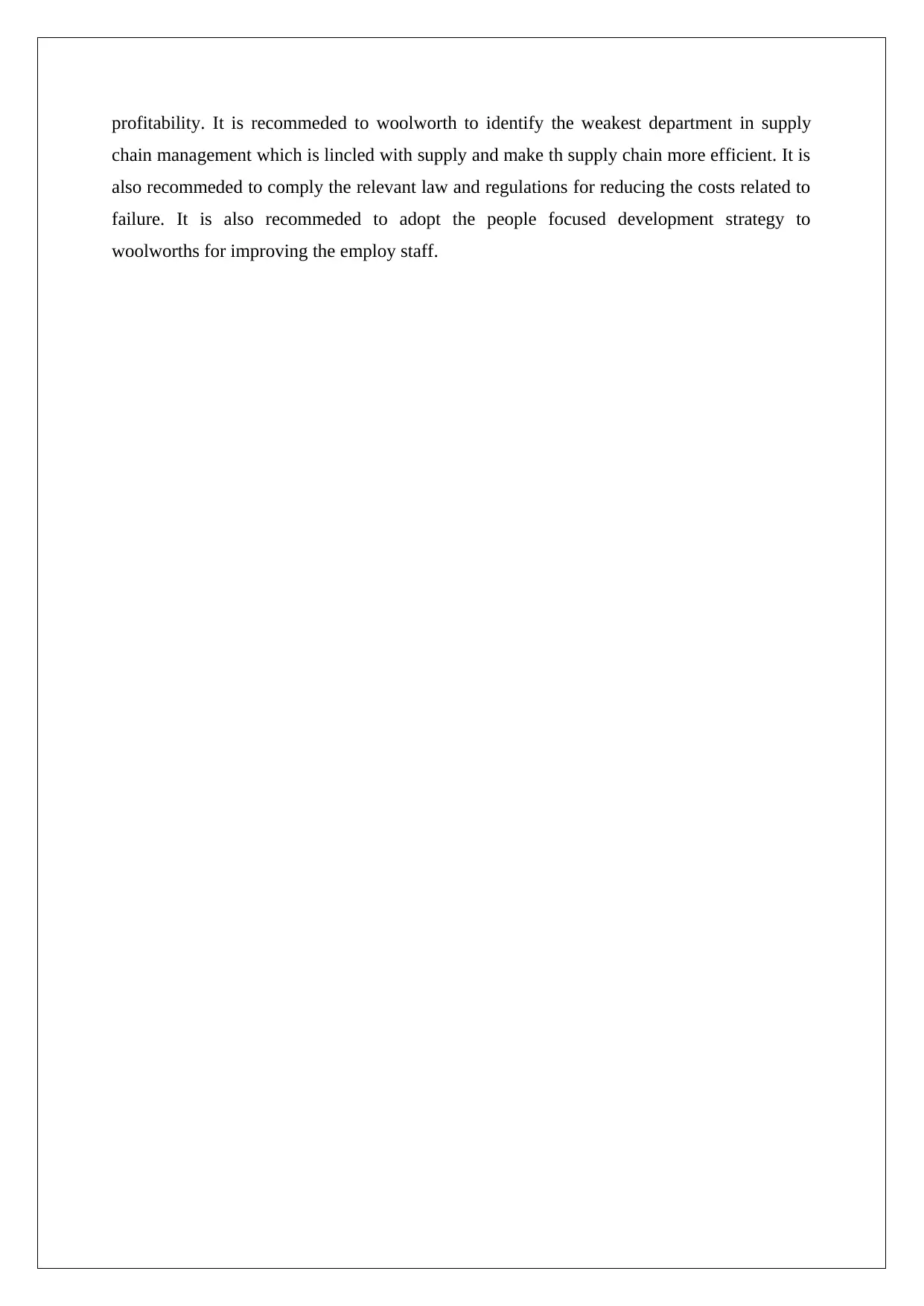
profitability. It is recommeded to woolworth to identify the weakest department in supply
chain management which is lincled with supply and make th supply chain more efficient. It is
also recommeded to comply the relevant law and regulations for reducing the costs related to
failure. It is also recommeded to adopt the people focused development strategy to
woolworths for improving the employ staff.
chain management which is lincled with supply and make th supply chain more efficient. It is
also recommeded to comply the relevant law and regulations for reducing the costs related to
failure. It is also recommeded to adopt the people focused development strategy to
woolworths for improving the employ staff.
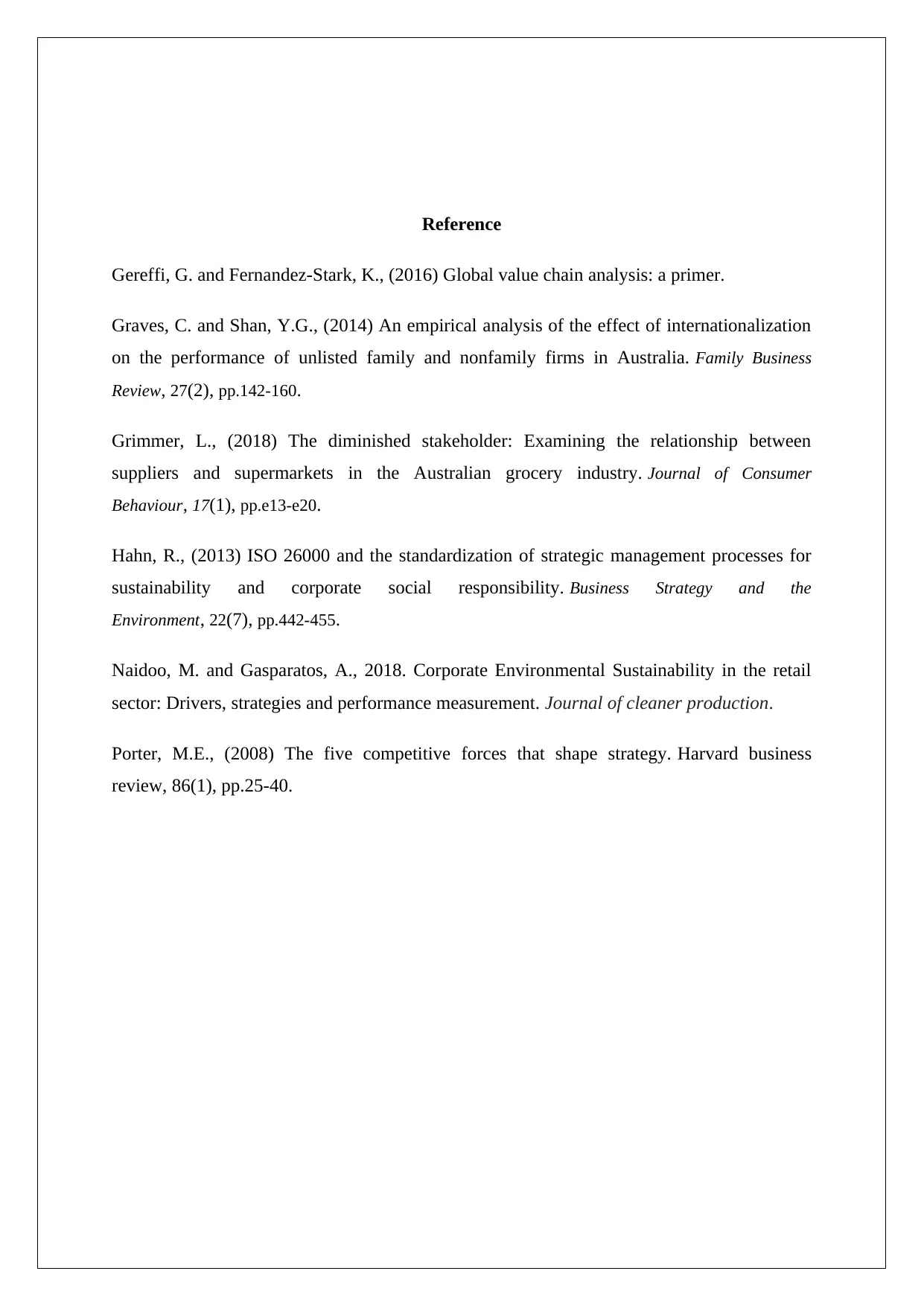
Reference
Gereffi, G. and Fernandez-Stark, K., (2016) Global value chain analysis: a primer.
Graves, C. and Shan, Y.G., (2014) An empirical analysis of the effect of internationalization
on the performance of unlisted family and nonfamily firms in Australia. Family Business
Review, 27(2), pp.142-160.
Grimmer, L., (2018) The diminished stakeholder: Examining the relationship between
suppliers and supermarkets in the Australian grocery industry. Journal of Consumer
Behaviour, 17(1), pp.e13-e20.
Hahn, R., (2013) ISO 26000 and the standardization of strategic management processes for
sustainability and corporate social responsibility. Business Strategy and the
Environment, 22(7), pp.442-455.
Naidoo, M. and Gasparatos, A., 2018. Corporate Environmental Sustainability in the retail
sector: Drivers, strategies and performance measurement. Journal of cleaner production.
Porter, M.E., (2008) The five competitive forces that shape strategy. Harvard business
review, 86(1), pp.25-40.
Gereffi, G. and Fernandez-Stark, K., (2016) Global value chain analysis: a primer.
Graves, C. and Shan, Y.G., (2014) An empirical analysis of the effect of internationalization
on the performance of unlisted family and nonfamily firms in Australia. Family Business
Review, 27(2), pp.142-160.
Grimmer, L., (2018) The diminished stakeholder: Examining the relationship between
suppliers and supermarkets in the Australian grocery industry. Journal of Consumer
Behaviour, 17(1), pp.e13-e20.
Hahn, R., (2013) ISO 26000 and the standardization of strategic management processes for
sustainability and corporate social responsibility. Business Strategy and the
Environment, 22(7), pp.442-455.
Naidoo, M. and Gasparatos, A., 2018. Corporate Environmental Sustainability in the retail
sector: Drivers, strategies and performance measurement. Journal of cleaner production.
Porter, M.E., (2008) The five competitive forces that shape strategy. Harvard business
review, 86(1), pp.25-40.
⊘ This is a preview!⊘
Do you want full access?
Subscribe today to unlock all pages.

Trusted by 1+ million students worldwide
1 out of 6
Related Documents
Your All-in-One AI-Powered Toolkit for Academic Success.
+13062052269
info@desklib.com
Available 24*7 on WhatsApp / Email
![[object Object]](/_next/static/media/star-bottom.7253800d.svg)
Unlock your academic potential
Copyright © 2020–2025 A2Z Services. All Rights Reserved. Developed and managed by ZUCOL.





